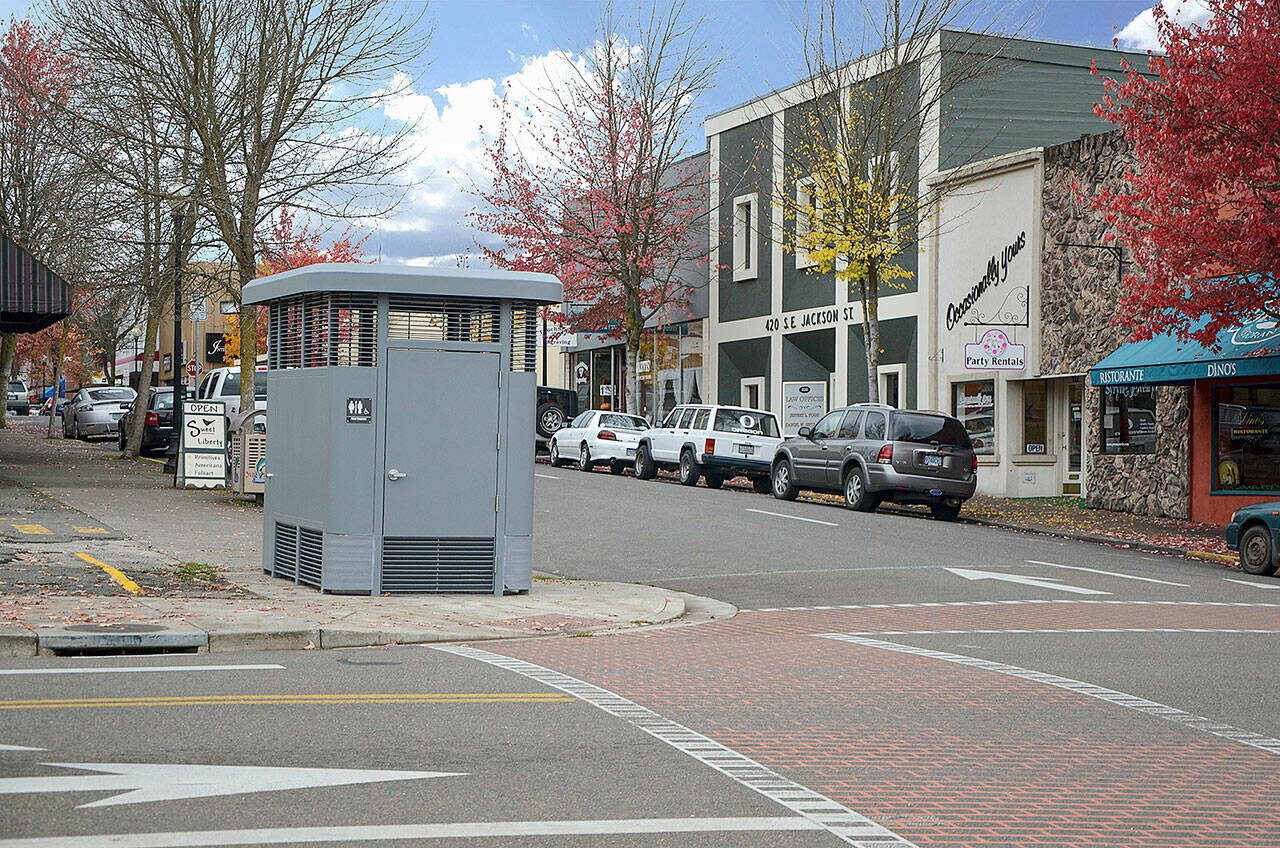By The Herald Editorial Board
A little more relief is coming to Everett streets, perhaps as early as July 4, as the city finishes work on four new restroom stalls downtown.
What some might have assumed was just another espresso stand going up, a small blue, white and brick structure next to the city’s Municipal Building, will instead help meet an urgent need for more public restrooms downtown, a recommendation made several years ago through a citizen-led process that became the city’s Safe Streets initiative, as reported by The Herald’s Sophia Gates.
The prefabricated building, built by Nevada-based Public Restroom Co. — which, thankfully didn’t get cute with its name — was delivered by truck and plumbed into the city’s sewer system. The relief station is advertised as low-maintenance, vandalism-resistant and free of other annoyances common to standalone portable toilets, while also being compliant with the Americans with Disabilities Act.
Another two single-stall restrooms, prefabricated by Roseburg, Ore.-based Romtec, also are being installed downtown, one near the Cape Gillette Theatre and the public plaza at 2730 Wetmore Ave, and the second at the Everpark Garage at 2815 Hoyt Ave.
The four stalls are an investment, totaling $1.5 million, funded through the covid-era federal American Rescue Plan Act and a $250,000 county grant. But cities across the country have spent more — and failed — to find a restroom solution that served basic needs of both the unsheltered and the general public and do so affordably.
Seattle, infamously, flushed $5 million down the toilet nearly 20 years ago when it deployed five sidewalk restrooms that were supposed to be self-cleaning but were difficult to maintain and too often allowed some to lock the doors and set up camp, encouraging drug use, prostitution and other problems.
More recently, as a response to the covid pandemic and the city’s homelessness problem, Portland, Ore., flooded city streets in 2020 with 130 of the plastic portable toilets — in bright red. Even the seemingly lower-cost portable plastic privies cost the city $75,000 a month to maintain. Within months the entire fleet had been vandalized or otherwise damaged and within three years were eliminated.
The problem seems to have been in finding a balance between costly site-built and fully appointed restrooms and lower-cost portable options that are serviceable for outdoor concerts and festivals but are prone to problems and annoyances when used as a longer-term fix. The solution, employed by both the one- and two-seat models coming to downtown Everett sacrifices some privacy for the user; both use grating or louvers that provide natural ventilation and signal when they’re in use, but encourage people to do their business, then move along, freeing up the facilities for the next occupant.
While the two-stall restroom offers interior sinks, some models use handwashing stations on the exterior of the restroom.
Sidewalk restrooms, similar to the Romtec model, are also built by Portland Loo, in its namesake city, and have been installed in Seattle, Kirkland, Shoreline and Olympia, and, no surprise, in Portland, which has adopted the restrooms with some civic pride, reports Bloomberg, specifically because they’re designed to be less-than-accommodating.
A Portland official told Bloomberg that Seattle’s failure was in making the restrooms too nice: “We think it was the design that was the fatal flaw. Trying to be comfortable and private makes people feel more empowered to do the illegal activities that people do in public toilets.”
Instead, keeping the stalls utilitarian and sturdy is working for cities, including Austin, Texas; Philadelphia, and Tuscon, Ariz., which is using a model that switches the interior lighting — visible from the outside — from green to blue when occupied, signaling when they are in use but also discouraging use for intravenous drugs because the blue light makes it difficult for drug users to find a vein, a Tucson TV station reported.
That Everett is looking at two different models of restroom will allow it to evaluate which could work best elsewhere as it looks to expand their availability in the future.
The business of doing one’s business — a very human process — should be easily accessible, clean, offer some balance of privacy and dignity. And be a relief for all.
Talk to us
> Give us your news tips.
> Send us a letter to the editor.
> More Herald contact information.

























